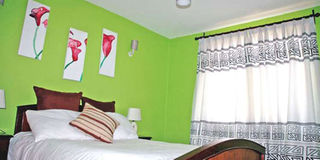Creating mood with colour

Lime green walls that create a bright and sunny mood in the bedroom. Green gives a fresh feeling to a space. It evokes thoughts of nature, which helps calm the mind. PHOTO | FILE
What you need to know:
- When decorating, it is important to consider a colour’s psychological effect. “In a space where you want someone to feel calm and at peace, use cool colours. If you want to have a more vibrant space where someone’s emotions will be excited, for example, in the dining room, go for warm colours.
- When creating a colour scheme, combine the cool colours with at least one neutral colour. This, Ms Kamau says, helps to balance the colours and offset natural light.
Colour is an important component of décor, yet many people remain unaware of its psychological effect.
Ms Muthoni Kamau, a Nairobi-based interior designer, defines colour psychology as the way colours affect a person’s emotions.
“There are three distinct colour classifications; cool, warm and neutral colours,” she offers. “Warm colours such as red, orange, yellow and brown resonate with fire and thus the ‘warm colour’ connotation; the opposite, cool colours which resonate with water include blue, green and grey. There are other colours that are neither hot nor cold. They are called neutral colours and include white, black and cream.”
So when decorating, it is important to consider a colour’s psychological effect. “In a space where you want someone to feel calm and at peace, use cool colours. If you want to have a more vibrant space where someone’s emotions will be excited, for example, in the dining room, go for warm colours,” Ms Kamau suggests.
Here are tips on using colour in the bedroom.
Green
Green gives a fresh feeling to a space. Ms Kamau says that it evokes thoughts of nature, which helps calm the mind. However, she caution against the use of very dark shades, saying they can make a bedroom dull, and thus depressing.
Ms Kamau says green is a good choice for babies, who need lots of sleep in a day. “It stimulates their senses and their imagination, and that calms them and helps them sleep,” she says.
If you want to do some matching, she says, green goes well with pale shades of blue and yellow. But if you want a pop of colour, throw in some orange as well. For example, you could have a cushion in orange or yellow, or some accessories in that colour to complement the walls.
She advises against the use of too much green on the walls without balancing it with neutral or warm colours, saying this can make the room visually cold.
Blue
To understand the effect of blue, Ms Muthoni explains the breathtaking feeling one gets when relaxing next to a pool, a pond, or even a river.
“The sight and sound of water generally calms a person’s nerves.” So when you paint your bedroom blue, it evokes memories of water and the sky and thus relaxes your mind for a good night’s sleep.
However, just like green, blue can make a bedroom very cold and “icy” if used in dark shades, so Ms Kamau recommends using mostly pale shades of it.
The size of the bedroom also matters. “If your bedroom is small, use pale shades of blue, otherwise, you can get away with one feature wall in a dark shade of blue and paler shades on the other walls for a large bedroom,” says Ms Kamau, adding that pale shades of cool colours tend to visually expand the room.
Blue works well with lavender (a shade of purple) as well as with shades of green, yellow and orange. For a boy’s bedroom, one can blend it with shades of red.
On balancing blue and other colours Ms Kamau says, “Have a pale shade of blue cover most of the space, then, at the bed’s headboard do a feature wall in a dark shade of the same blue colour. To complete the look, add some colourful bedding and combine that with some texture from floor rugs, fabrics, artistic objects and books. And flowers will definitely add a special touch to the room.”
Purple
Purple is a feminine colour works best in a woman’s bedroom. It is associated with royalty and gives the bedroom a grand feel. Some of its common shades that are suitable for the bedroom are lavender and raspberry (a warm shade that is close to maroon).
“Lavender gives the bedroom a delicate appearance. It is this “softness” and “gentleness” that makes it suitable for a little girl’s room,” says Ms Kamau, adding that it blends well with some shades of yellow, green, grey, silver, and, for a grand feel, one can combine it with gold.
“Purple has a calming effect,” notes Ms Kamau, adding that lavender fragrance is commonly used to induce sleep, and that people put also add the lavender herb in their tea to induce sleep.
“Some of those qualities psychologically bounce off on the mind when you see the colour,” she says.
Neutral colours
When creating a colour scheme, combine the cool colours with at least one neutral colour. This, Ms Kamau says, helps to balance the colours and offset natural light.
“Colours like cream reflect light, making the room warm and easy on the eye. Generally, we tend to avoid white except for the ceiling because white in its pure form is a very stark, clinical colour. If you have to use it, combine it with other warmer colours. Black can be very sophisticated. It cannot be used in large amounts in the bedroom because it can subdue the emotions so much that the room becomes depressing. Use these colours for accessories such as a vase, a wall clock, etc.” says Ms Kamau.“Colours like cream reflect





